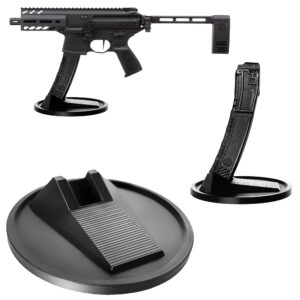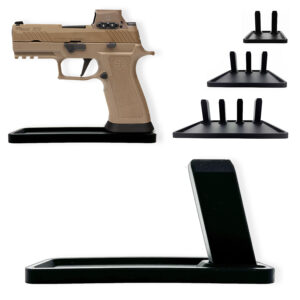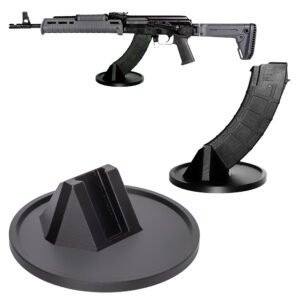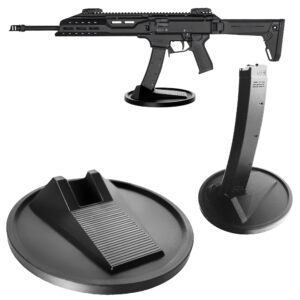
Categories:
The AR-10 magazine is a critical component in the functioning of the AR-10 rifle, serving as both a reservoir and a feeder for ammunition. Designed to hold multiple rounds, typically 20, 25, or 30 cartridges depending on its capacity, the magazine ensures a steady supply of bullets to the chamber, enabling semi-automatic or automatic firing sequences. This device is engineered with precision to perform smoothly, reliably, and efficiently under various conditions.
Constructed from robust materials such as steel or polymer, the AR-10 magazine is designed to withstand rigorous use, including exposure to harsh weather and rough handling. Its tensile strength ensures that it can endure the high-pressure environment of the gun’s operation without succumbing to physical degradation. A durable spring inside the magazine maintains consistent pressure on the stack of cartridges, allowing each round to move upwards towards the feeding lips as the previous one is chambered and fired.
Beyond its basic function of holding and feeding ammunition, the AR-10 magazine plays an instrumental role in the overall balance and handling of the rifle. Its design details, such as the magazine catch and release mechanism, are crucial for quick reloads and operational efficiency. The weight and fit of a fully loaded magazine can affect the center of gravity of the rifle, influencing accuracy and shooter comfort.
Ease of maintenance is another critical aspect of the magazine’s design. Simple disassembly mechanisms allow users to clean and inspect the magazine, ensuring debris and fouling do not impede its function. Such maintainability extends the lifespan of the magazine and contributes to the reliable performance of the AR-10 rifle.
Operational reliability also relies heavily on the standardization of magazines to be produced in accordance with strict military and industry specifications. Consistency in design and manufacturing processes ensures that any magazine can be trusted to perform interchangeably with any compatible AR-10 rifle, an attribute of critical importance for both civilian enthusiasts and military personnel.
Moreover, advancements in magazine technology have led to enhanced features such as anti-tilt followers, which prevent jamming and ensure a smoother feeding operation. High-quality finishes and coatings can protect against corrosion and wear, further enhancing durability.
In sum, the AR-10 magazine is an indispensable component of the rifle, meticulously designed to perform its dual roles of ammunition storage and feeding with unmatched efficiency and reliability. Its construction, functionality, and maintainability are tailored to ensure optimal performance in both everyday use and challenging environments.
The design and construction of the AR-10 magazine play a critical role in ensuring the reliable feeding of ammunition into the chamber, which is essential for the optimal functioning of the gun. The AR-10 magazine is typically made from either robust steel or lighter, more modern composite materials like polymer, ensuring durability while maintaining a manageable weight. The choice of material impacts the magazine’s resilience to various environmental conditions, such as extreme temperatures and rough handling, which can be encountered in diverse field operations.
In terms of design, the AR-10 magazine features a straight or slightly curved profile, with the curvature aligning with the natural stacking of the cartridges, facilitating smoother feeding. The internal geometry of the magazine is meticulously engineered to ensure that the rounds are properly aligned and guided towards the feed lips, reducing the likelihood of jams or misfeeds. The feed lips, usually reinforced and precisely machined, are critical components that control the release of the cartridge as the bolt cycles.
The height and angle of these feed lips are finely tuned to match the feeding mechanism of the rifle, thus securing the round until the bolt strips it from the magazine and directs it into the chamber.
The spring and follower system within the AR-10 magazine are equally vital. The spring, often made of high-tensile steel, exerts consistent pressure to push the follower and the rounds upwards. This upward pressure must be uniform to prevent the bullets from tilting or shifting unpredictably, which could compromise feeding reliability. The follower, usually crafted from a wear-resistant polymer or light metal, ensures that each round ascends towards the feed lips in the correct orientation.
Modern AR-10 magazines may incorporate anti-tilt followers, designed to eliminate the binding and shifting that could disrupt the loading process.
The magazine body itself is often designed with ribbing or stippling for enhanced grip, facilitating easier manipulation during loading and unloading, even under adverse conditions. The base plate is typically removable, allowing for easy disassembly and maintenance. This feature is crucial for cleaning and ensuring the longevity of the magazine, as debris and residue can accumulate over time, potentially hindering performance.
Overall, the design and construction of the AR-10 magazine embody a balance of rugged functionality and precision engineering, aimed at delivering reliable performance under various operational circumstances, thus playing a pivotal role in the effectiveness of the AR-10 rifle.
When discussing the capacity and variants of AR-10 magazines, it is essential to recognize the diverse range of options available to accommodate different operational needs and preferences. The standard capacity of an AR-10 magazine typically hovers around 20 rounds. This 20-round magazine provides a balance between sufficient firepower and manageable form factor, making it a popular choice for many enthusiasts and professionals.
However, manufacturers offer a variety of magazine capacities to suit various applications, going beyond the standard to cater to specialty uses and user preferences.
In addition to the prevalent 20-round magazine, there are smaller capacity options such as 5-round and 10-round magazines. These lower-capacity magazines are often favored for hunting, where local regulations may mandate a maximum number of rounds. The reduced capacity also provides a more lightweight and manageable configuration, which can be advantageous during extended periods of carry or when precision and minimal bulk are required.
At the other end of the spectrum, higher-capacity magazines such as 25-round, 30-round, and drum magazines are also available. These options are particularly beneficial for competitive shooting, law enforcement, and military uses where a higher volume of firepower is necessary. The increased capacity minimizes the frequency of reloads, thereby allowing for sustained engagement during critical moments.
The materials used in AR-10 magazines also speak to their varied designs and purposes. Aluminum and steel magazines are known for their robust construction and durability, making them suitable for rigorous and demanding environments. On the other hand, polymer magazines are appreciated for their lightweight nature and resistance to corrosion, offering a different set of advantages. These materials go a long way in determining the overall weight, balance, and ease of carry of the AR-10 rifle.
Moreover, some magazines are designed with specific features such as windowed bodies that allow users to visually check the remaining ammunition, anti-tilt followers to ensure reliable feeding, and reinforced feed lips for added longevity and improved performance. These enhancements address both practical and tactical aspects, ensuring that users can rely on their magazines under various conditions.
In conclusion, the AR-10 platform benefits from a broad spectrum of magazine capacities and designs. Whether prioritizing a compact and light load for hunting, or demanding a high-capacity option for sustained fire in competitive or tactical scenarios, the array of available AR-10 magazines caters to a wide range of requirements and preferences. This versatility ensures that every user can find a magazine that aligns with their specific needs.
Loading ammunition into the AR-10 magazine is a crucial process to ensure that the rifle operates smoothly and performs reliably. The AR-10, known for its versatility and power, uses detachable box magazines that hold varying numbers of rounds, with common capacities being 10, 20, or even 25 rounds. Handling the magazine properly, along with the ammunition, is essential for both the functionality of the gun and the safety of the shooter.
Before starting, it is important to ensure that the gun is unloaded and pointed in a safe direction with the safety engaged. The magazine should be checked for any signs of damage or debris that could impede the proper seating and feeding of rounds. Many shooters prefer using gloves for better grip and protection, although it is not strictly necessary.
To begin loading the magazine, grasp it firmly in one hand with the feed lips facing upwards. Use your free hand to take a round of ammunition, positioning it so that the projectile faces forward, towards the direction the bullets will travel when fired. The base of the cartridge should align with the magazine feed lips. Exert downward pressure on the round, followed by a slight backward push to ensure it clicks into place between the feed lips and the magazine’s internal follower.
Repeat this process, adding one round at a time while ensuring each cartridge is seated properly. Pay attention to the orientation of the rounds to prevent misfeeds; all should be aligned uniformly. For high-capacity magazines, maintaining uniform pressure can become challenging as the spring tension increases. It might be helpful to use a loading tool or a magazine loader, which can simplify the process and reduce strain on fingers.
Once you have inserted the desired number of rounds, give a slight tap on the back of the magazine to help settle the ammunition. Check the feed lips again to ensure no rounds are protruding abnormally. A properly loaded magazine will prevent double feeds or failures to feed, common issues that can result in jams and malfunctions during firing.
Loading ammunition remains a fundamental skill for any AR-10 user, directly influencing the rifle’s reliability and performance in a given scenario, whether it be for sport, hunting, or tactical purposes. Taking care to load the magazine correctly will enhance the shooting experience, ensuring each round chambers smoothly and the rifle operates as intended.
The AR-10 magazine is a crucial component of the rifle’s design, responsible for holding ammunition and ensuring that each round is reliably fed into the chamber during firing. The magazine is typically made of durable materials such as polymer or metal to withstand the rigors of use in various conditions, including combat and harsh environments. It is designed to accommodate a specific number of rounds, often 20 or 25, though capacities can vary depending on the user’s needs and the jurisdiction’s legal restrictions.
The feeding mechanism of the AR-10 magazine begins with the way in which the ammunition is loaded. Rounds are stacked in a double-stack configuration, a common feature in larger caliber rifles that allows for a higher ammunition capacity without increasing the magazine’s length excessively. This arrangement is supported by a spring-loaded follower, a precisely engineered piece that helps guide the ammunition upward as each round is fired and the subsequent round is stripped from the magazine.
When the AR-10 rifle is fired, the bolt carrier group moves rearward under the energy generated by the expanding gases from the fired cartridge. As the bolt carrier group cycles back, it ejects the spent casing and then compresses the magazine spring slightly before moving forward again, driven by the buffer spring. During this forward motion, the bolt catches the next round in the magazine and pushes it into the chamber.
This seamless interaction between the bolt carrier group and the magazine is crucial for maintaining the rifle’s reliability and readiness in rapid-fire scenarios or high-stress situations.
The magazine itself features feed lips at the top that position the rounds properly and ensure they are aligned with the chamber. These feed lips are meticulously designed to provide the correct angle to facilitate smooth and consistent feeding. Any deformation or damage to the feed lips can result in misfeeds or failures to feed, which underscores the importance of maintaining the magazine in good condition.
Additionally, the follower and spring must be kept clean and free of debris to maintain proper tension and movement.
Overall, the AR-10 magazine’s feeding mechanism is a sophisticated interplay of mechanical components that work in unison to deliver ammunition reliably to the rifle’s chamber. Understanding and maintaining this system are vital for anyone who relies on the AR-10 for any application, whether it be sport shooting, hunting, or defensive use.
Maintaining and caring for your AR-10 magazine is essential for ensuring reliable performance and longevity. Magazines are a crucial component of your gun, and neglecting their maintenance can lead to malfunctions, misfeeds, and a decrease in overall gun reliability. Regular cleaning and inspection should become a routine part of your gun maintenance activities.
Begin by unloading your magazine completely to eliminate any risk of accidental discharge. Disassemble the magazine carefully, making sure to remove the base plate, spring, and follower. Using a soft cloth or a brush, clean the outer surface of the magazine body to remove any dirt, debris, or carbon build-up. For the interior of the magazine, a soft brush or compressed air can be utilized to dislodge any foreign particles trapped inside.
Focus on cleaning the spring, follower, and feed lips meticulously. Dirt and debris on these parts can affect the smooth feeding of rounds into the chamber. If the spring shows signs of rust, it should be addressed immediately to prevent further degradation. A light application of a suitable gun oil can help protect the spring from moisture. However, be careful not to over-lubricate, as excessive oil can attract more dirt and debris.
Inspect the magazine for any signs of wear or damage. Pay particular attention to the feed lips, as they are crucial for maintaining proper alignment and feeding of rounds into the chamber. Any bending, cracking, or warping of the feed lips can cause significant feeding issues. If you notice any such damage, it might be time to replace the magazine or the affected parts to ensure reliability.
Proper storage of your AR-10 magazine is equally important. Store magazines in a cool, dry place, preferably in a sealed container to protect them from moisture and dust. When not in use, avoid leaving magazines loaded for extended periods as this can weaken the spring over time, potentially leading to feeding issues.
Regularly rotate your magazines to ensure that no single magazine bears the brunt of repeated use. This practice will help extend the life of all your magazines and ensure consistent performance. By incorporating these maintenance and care procedures into your routine, you can significantly enhance the reliability and lifespan of your AR-10 magazines, ensuring that they function flawlessly when you need them most.
When it comes to guns, reliability is paramount, and this is especially true for AR-10 magazines, which play a crucial role in feeding rounds into the chamber. However, like any mechanical component, AR-10 magazines can experience issues that impact the overall performance of the gun. Understanding and troubleshooting these common problems can ensure that your AR-10 operates smoothly and efficiently.
One of the most prevalent issues with AR-10 magazines is failure to feed, where rounds are not properly inserted into the chamber. This can be caused by several factors, including a damaged or worn-out magazine spring. Over time, the spring can lose its tension, leading to inconsistent feeding of ammunition. Replacing the spring or the entire magazine is often the most effective solution.
Another common issue is misfeeding, where the rounds are not aligned correctly, causing jams or stoppages. This can result from a bent or damaged feed lip. The feed lips guide rounds from the magazine into the chamber, and any damage can disrupt this process. Inspecting the feed lips and carefully bending them back into the correct shape or replacing the magazine can resolve this problem.
Double feeding, where two rounds are fed simultaneously causing a jam, is another frequent issue. This can be particularly concerning as it compromises the gun’s reliability and can be difficult to clear. Double feeding may occur due to weak magazine springs, damaged followers, or worn-out feed lips. Ensuring that the magazine is in good condition and that springs and followers are functioning correctly can prevent double feeding.
Failure to lock back on the last round is an often overlooked issue that can occur with AR-10 magazines. This can be caused by a weak or faulty magazine follower that fails to engage the bolt catch. Replacing the follower or using a different magazine can resolve this problem. Additionally, checking for proper lubrication and cleanliness within the magazine can enhance its performance.
Lastly, dirt, debris, and lack of maintenance can exacerbate these issues. Regularly cleaning and inspecting your AR-10 magazines can mitigate many common problems. Disassembling the magazine, cleaning the internal components, and ensuring they are properly lubricated can maintain consistent feeding and reliable performance.
In summary, while AR-10 magazines are generally reliable, they can encounter common issues such as failure to feed, misfeeding, double feeding, and failure to lock back on the last round. Regular maintenance, inspection, and timely replacement of worn-out components are key to ensuring that your AR-10 remains reliable and efficient in the field.








Colt
Colt M4 Carbine
Colt LE6920
Colt AR-15 A4
Daniel Defense
DDM4 V7
DDM4 V9
DDM4 V11
DDM4 ISR (Integrally Suppressed Rifle)
Smith & Wesson (S&W)
M&P15 Sport II
M&P15 Tactical
M&P15T
Bravo Company Manufacturing (BCM)
BCM Recce-16
BCM Recce-14
BCM MCMR Series
Aero Precision
M4E1 Series
AC-15
AR15 Pistol (Various Configurations)
Ruger
Ruger AR-556
Ruger SR-556
Ruger AR-556 MPR (Multi-Purpose Rifle)
Springfield Armory
Saint Victor
Saint Edge
Saint AR-15
PSA (Palmetto State Armory)
PSA PA-15
PSA AR-V
PSA Jakl (AR Pistol)
FN America
FN 15 Tactical Carbine
FN 15 Patrol
FN 15 DMR
Wilson Combat
Recon Tactical
Super Sniper
Protector Carbine
SIG Sauer
SIG M400 Tread
SIG M400 Elite
SIG M400 SDI
LWRC International
IC DI (Direct Impingement)
IC SPR
IC A5
Bushmaster Guns
XM-15 QRC
Bushmaster MOE
XM-15 Patrolman
Rock River Arms
LAR-15 Entry Tactical
LAR-15 Predator
LAR-15 Elite Comp
Stag Arms
Stag 15 Tactical
Stag 15L (Left-Handed Models)
Stag 15 Valkyrie
Noveske Rifleworks
Noveske Gen 4 N4
Noveske Space Invader (AR Pistol)
Noveske Recon
Anderson Manufacturing
AM-15 Optic Ready
AM-15 M4 Carbine
AM-15 Precision Rifle
Adams Arms
AA-15 Piston Rifle
P2 AARS (Adams Arms Rifle Series)
Black Rain Ordnance
SPEC15 Series
BRO Predator
Fallout 15
Diamondback Guns
DB15 Series
DB15CCMLB
DB15EB
Del-Ton Inc.
DTI-15
Del-Ton Echo 316H
Sierra 316M
Windham Weaponry
Windham SRC
Windham VEX-SS
Windham RMCS-4 (Caliber Conversion System)
Christensen Arms
CA-15 G2
CA-15 Recon
CA-15 Titanium Edition
Patriot Ordnance Factory (POF-USA)
Renegade Plus
P415 Edge
Revolution DI
LaRue Tactical
PredatAR
OBR (Optimized Battle Rifle)
LaRue Stealth 2.0
Battle Arms Development
Workhorse Patrol Carbine
BAD556-LW (Lightweight)
Authority Elite Rifle
Faxon Guns
Ascent AR-15
FX-19 (AR Pistol)
Streamline Ultralight Series
KE Arms
KE-15 SLT (Super Lightweight Tactical)
KE-15 Scout Carbine
Primary Weapons Systems (PWS)
MK1 MOD 2-M
MK116 PRO
MK107 (Piston AR Pistol)
ZEV Technologies
ZEV Core Elite Rifle
ZEV AR15 Billet Rifles
Franklin Armory
BFSIII AR-C1
Militia Model
F17-L (Chambered in .17 WSM)
Seekins Precision
SP15 DMR
NX15 Skeletonized Rifle
Havak Bravo
Aero Precision (Additional Models)
EPC-9 (Pistol Caliber ARs)
VG6 AR Rifles
Barrett Guns
REC7 DI
REC7 Gen II
CMMG
MK4 RCE
Resolute 300
Banshee (AR Pistol)
DPMS Panther Arms
Panther Oracle
Panther LR-308
H&K (Heckler & Koch)
HK MR556A1
HK416 (Military Variant)
Rock Island Armory (Armscor)
VR-80 Tactical AR (Shotgun AR Platform)
Troy Industries
Troy SPC-A3
Troy PAR (Pump Action AR)
Wilson Tactical
Tactical Recon AR
Protector Series
F1 Guns
FDR-15 Skeletonized Rifle
BDRx-15 Series
Juggernaut Tactical
JT-15
JT-10 Precision Rifle
AeroSurplus
Surplus AR-15 Rifles (Budget Models)
Thunder Tactical
AR-15 Basic Carbine
Tactical Builder Sets
Radical Guns
RF-15
Forged AR-Series
Dark Storm Industries
DS-15 Featureless Rifles
DS-10 Typhoon
DRD Tactical
Paratus
Aptus AR Rifles
Bear Creek Arsenal
BCA-15
AR Complete Upper Builds
Aero Survival Rifles (ASI)
ASR Tactical Series
Tactical Edge
WARFIGHTER Series
AR-15 Lightweight Rifles
Lone Star Armory
TX15 DMR
TX15 Carbine
HERA Arms
HERA H7
HERA AR-15 Lower Builds
IWI (Israeli Weapon Industries)
Zion-15
DRD Tactical
Tactical Modular Rifles
Quick-Takedown Rifles
V Seven Weapons
1776 Rifle
Hyperlite Rifle
Core Rifle Systems
Core15 Tac III
Core15 Patrol Rifle
Armalite (Original AR-15 Creator)
M15 Tactical
M15 A4 Carbine
DEF15 (Defensive Sporting Rifle Series)
PSA (Palmetto State Armory Additional Models)
PSAK-47 Hybrid (AR-AK Style Hybrid)
PSA Dagger (Pistol Caliber Configurations)
Odin Works
OTR-15
Odin Recon Rifle
Maxim Defense
MDX-508 PDX (Compact AR Pistol)
MDX-510 Rifle